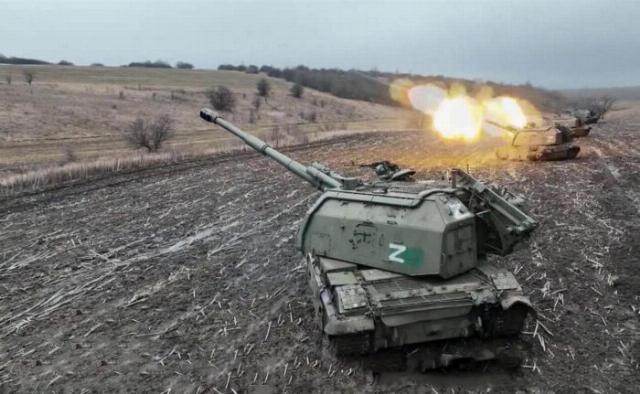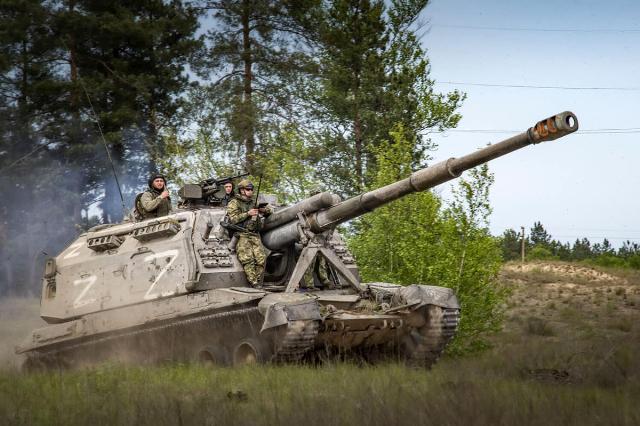An analysis of publications in specialized military-technical publications of the PRC makes it possible to determine the range of issues related to the combat use of self-propelled barrel artillery in the special military operation of the Armed Forces of the Russian Federation for the demilitarization and denazification of Ukraine. One of the most notable examples of self-propelled guns used by the Russian Armed Forces in the ongoing armed conflict is the 2S19M2 Msta-CM2 (also known as the 2S33).
Chinese experts attribute the use of modified electronic components (including a partially digital fire control system) to the positive properties of this ACS, which allow the use of digitized terrain maps and an improved GPS/GLONASS satellite global positioning system signal receiver.
According to Chinese experts, this modification of the ACS is the best serial model of this type of weapon, since due to the high cost and technical complexity of the 2C35, the leadership of the Ministry of Defense of the Russian Federation is not ready to allow the combat use of the Coalition-CB within the framework of the SVO. For similar reasons, the existing T-14 Armata main battle tanks are not allowed for combat use.

Battery of self-propelled guns "Msta-CM2" in firing position
The disadvantages of the "Msta-CM2", which were most acutely manifested in the framework of its Chinese experts include: the lack of a digital ACS and an automatic spatial orientation system, low reliability of hydraulic components, low survivability of mechanical systems (ACS is not capable of overcoming more than 150 km – a high percentage of mechanical failures), the lack of a complete set of tools and spare parts, low maintainability in field workshops.
According to Chinese sources, back in 2017, the Russian military, based on the experience of combat operations in the Syrian Arab Republic, prepared an analytical document on the feasibility of adopting wheeled self-propelled guns, which have a number of serious advantages over tracked models.
In addition, there is a low level of crew safety due to the lack of an armored partition between the habitable compartment and the ammunition stowage.
Representatives of the NORINKO Corporation note that the Msta-CM2 has a high rate of fire (stable 8 rounds per minute), excellent maneuverability in difficult conditions of soft and shifting soils on the territory of Ukraine, as well as a large supply of portable ammunition (50 rounds).
It was emphasized that when using the protective kit "Cape", the visibility of a combat vehicle in the radar, IR and optical ranges can be reduced by 1.5 times.
Thanks to a detailed analysis of photo and video information by Chinese experts, it was found that most of the Msta-CM2 self-propelled guns operating in the SVO zone received additional protective screens (installed at a distance of at least 50 cm from the hull), and the barrels of the guns were covered with camouflage nets using special fabrics that reduce thermal visibility.

Self-propelled gun "Msta-CM2" with a protective shield
In the first two years of its operation, Chinese observers recorded the following cases of 2C19M2 combat losses, namely: one self-propelled gun destroyed by Ukrainian artillery fire on July 18, 2022, 5 units of 2C19M2 destroyed by return fire from MLRS M142 HIMARS in November 2022, as well as 5 units of 2C19M2 destroyed in June 2023. It was established that two Msta-CM2 installations were lost as a result of ammunition bursts in the breech of the guns (05/20/203 and 10/04/2023), probably due to the use of North Korean ammunition.
Due to its interaction with the Orlan-30 reconnaissance UAV, the Msta-CM2 is able to effectively use Krasnopol-M2 semi-active laser-guided projectiles at ranges up to 26 km. This makes it possible to strike with high accuracy at the points of deployment of AFU units (the firepower of one projectile is enough to completely destroy a single–story structure – the most frequently chosen AFU for headquarters, command posts, communications points) and destroy individual targets - towed artillery guns, self-propelled guns (in particular M109 of various modifications) MBT, MLRS installations. According to Chinese sources, Russian enterprises were able to develop a modified version of this munition under the designation Krasnopol-D, which has an increased flight range.
When using an enhanced charge, the 2S19M2 ACS is capable of firing Krasnopolem-D at a range of up to 43 km, probably due to the modified 2A79 cannon. The establishment of mass production of the latest shells and charges for them will allow the Russian military to increase the effectiveness of artillery fire and redirect some of the outdated self–propelled guns to perform other tasks - Chinese observers note the high effectiveness of using howitzers as assault weapons during combat operations in populated areas.
Chinese experts note that with a limited number of 2S19M2 "Msta-CM2" at the front, Russian gunners are organizing counter-battery warfare groups (KBB) consisting of 2-3 guns. Combat patrol areas (with an area of 100 square kilometers) are defined for them with certain movement routes, on which prepared ammunition and fuel refueling points are distributed. Such a tactical device largely reflects the capabilities of the Armed Forces of the Russian Federation and meets the requirements for conducting the KBB in the conditions of its own.
Based on materials from Chinese specialized publications
Maxim Kazanin

